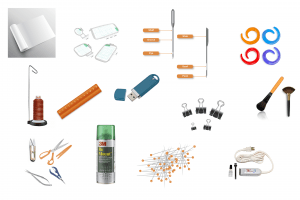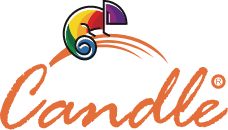Even though there are many guidelines available on the internet when it comes to embroidery and its accessories yet they are all scattered all over and it take time to search and conclude all the necessary items that you need to purchase. Here is the one complete essential guide for embroidery threads, accessories and tools that you will need when you start your machine embroidery journey as a beginner.
Are you confused between machine embroidery threads and sewing threads? even though they might look similar, but there are a lot of difference which set them apart. Embroidery threads have higher strength to withstand wear and tear of machine embroidery, they are finer and create aesthetically beautiful designs. Sewing threads lack sheen as they are used for joining two materials together to make a garment and are hardly visible on the upper surface.
Embroidery threads are the main ingredient when it comes to machine embroidery. However, there are few types of embroidery threads available in market that you need to choose from. You will also need to decide the right weight of thread and as well as the price that you want to spend on them. Read below our detailed guidelines to help you decide.
Thread Weights
Embroidery threads are available in different weights ranging from 30 to 120. As a general thread rule, higher number represents finer threads while lower number represents heavier one which you will not be able to see with bare eye. For example, 60 will be finer than a 40. To identify embroidery threads weight, there is a number mentioned on the spool. There is also one more information mentioned on the spool that is ply. Sometimes 50/2 is mentioned on the spool which indicates the weight 50 that is made with two ply/strands.
Expensive Vs Cheap
Although a lot of people will advocate cheaper embroidery threads, I believe in investing in better quality embroidery threads because the initially upfront cost may look higher but the cost effectiveness will make it a better choice. Investing in higher quality threads will result in spending less time doing rethreading, repairing and maintenance work for machine. This will result in better products and higher efficiency which will negate the higher cost of the embroidery machine threads.
However, you need to consider what your customer wants and how much they are willing to pay. If they are not ready to pay for higher quality then you have to work with budget friendly products and add those overheads of machine downtime and maintenance to the final cost.
Types Of Threads
Polyester
Polyester threads are synthetic threads that have various advantages making them a favorite for embroiderers. Polyester threads are shiny and come in brilliant hues. They are resistant to bleach and have higher tensile strength making them ideal choice for beginners. Since they have higher strength, they break less often which reduces the machine rethreading downtime tremendously.
Cotton
Cotton thread made of natural fiber is an environmentally friendly product as it is 100% biodegradable. Designs made from cotton look fuller in comparison to others and cotton threads may break often during machine embroidery as they are not strong enough in comparison to synthetic threads like Polyester and rayon. However, cotton being sustainable and eco product has its edge being green product for environment.
Metallic
Metallic threads are used for decorative stitching to give the embroidery a sparkling effect. Metallic threads create beautiful aesthetics however there are some precautions that needs to be taken when running metallic threads. You have to ensure that you clean the machine and change the needles to new ones to ensure that machine is in perfect working condition. You also need to use a bigger needle with bigger eye hole as if you use small eye hole, the metallic thread will shred and break often due to wear and tear.
Silk
Silk threads are the most elegant looking threads and come in wide variety of colors as they have exceptional dyeability. Even though they look delicate, they are very elastic, sturdy and strong.
Rayon
Rayon is also a popular choice when it comes to machine embroidery. Rayon threads are shiny, colorful, durable and low cost.
Top Embroidery Tools And Accessories
When it comes to embroidery, the first thing that comes to your mind is embroidery machine while there are many other essential tools and accessories related to thread that will make your life easy and help you design professional projects.
1. Embroidery Stabilizer
When it comes to machine embroidery, there are few essentials that you can’t work without. Embroidery stabilizer is one of them. Let’s dive into different types of stabilizers used with different materials for machine embroidery.
As the name suggests, Tear-Away Stabilizers are supposed to be torn away from actual fabric or material hence they have to be sturdy. Woven fabrics with compact construction like canvas and cotton as fiber are the ones which need tear-away stabilizers.
Sticky Stabilizers are very useful when you want the stabilizer and fabric to stay in one position. Even though you can use temporary adhesive, but sticky stabilizers are much better option than the adhesives as the temporary adhesive will cause a lot of mess and you will have to clean and maintain machine each time you use them.
Cut-Away Stabilizers are suitable for fabrics that have stretch. These stabilizers are used with knitted fabric as these fabrics require a lot of support.
Water Soluble Stabilizers dissolve upon washing up and are used with fabrics where you want the stabilizer to disappear completely. These stabilizers are also used for stand-alone laces where support is essential for embroidery.
2. Thread Stands
Thread stand might not look essential but is one thing you really need to invest in. A thread stand will help you in two ways; firstly, it will help you in managing multi color threads used in same project. Secondly, it will help in reducing extra resistance caused by the bigger spools that you invest in.
3. Nippers
Nipper is a tool that looks a lot like scissors with only the difference in blade size and addition of a spring that brings the nipper blades back to their position without any effort from user. Nippers help cut the thread as closely as possible giving the embroidered design a finished look.
4. Thread Conditioner
Thread conditioner is used when you want to avoid or reduce tangling of the threads. They are also used when you want the thread quality to improve and cause less friction hence less breakage as a result. Thread conditioner in a way also strengthens the thread making it easier to glide through the fabric during the embroidery process.
5. Bobbin
Bobbin is a small spool that holds the thread that can be fed to needle to form a stitch. Without the bobbin thread, needle can’t form a stitch.
6. Bobbin Case
Bobbin case is a small compartment like device that is used to hold the bobbin so that bobbin thread can be fed to form an embroidery stitch.
7. Needles
There are three types are needles used in machine embroidery depending on the fabric type you are using. Sharp, ballpoint and universal needles are three types that you will be using depending on material. Sharp tip needles are used when the fabric is a tightly woven construction and made of cotton. The sharp tip penetrates through the fabric making a hole each time it forms a stitch. The ballpoint tip needle is used when you want to embroider on a knitted fabric. The ballpoint needle does not penetrate the material but rather it moves the yarn away to make a place for stitch. This is essential for knitted fabrics as if there is hole every time, the knitted fabric will start to unravel due to damage to loops that form the knit fabric. Universal needles have a slightly round tips and are suitable for light and medium weight fabrics. Universal needles can cover wide range of fabrics and materials making them a good choice when you are unsure of what to use.
8. Thread Eraser
Thread eraser is a tool that helps shave the threads off the fabric in case you have made a mistake. This tool can only be used if the fabric you are using is durable and sturdy enough as otherwise the thread eraser will damage the base fabric as well.
9. Embroidery Hoops
Embroidery hoops come in many shapes and sizes. For deciding what size and shape to buy, this decision is dependent on the size of your embroidery design. They are basically used to hold the material or fabric you are using in one place and keep them stable and taut. Hoop keeps the fabric from shifting or stretching hence saving the design from being distorted or uneven.
10. Spool Huggers
Spool huggers are multi-purpose items that will not just help you from unraveling your embroidery spools but also keep the extra fabric away from embroidery needle while the machine is at work.
11. Binder Clips And Quilting Pins
While you are running an embroidery project there is a chance of extra fabric being sucked into the embroidery machine needle. If that happens, you will have to stop the machine and shave off the threads. This can damage your base fabric and increase down time for machine. A binder clip is something which can come in handy for saving you from this trouble.
Quilting pins can also be very useful for keeping the fabric in one place and keeping extra fabric from being sucked in the embroidery machine.Conclusion:
When you are diving into the embroidery design as a beginner, it is always very helpful to have all the useful tools in advance making your embroidery experience easy and enjoyable. Good tools and good threads differentiate you from your competitors by giving your final design that finished professional look that every customer is looking for.

